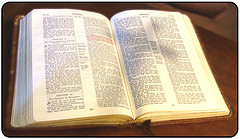Did you know that the Bible was not written in chapter and verse form? Chapters were first introduced in 1227, by Stephen Langton. Robert Stephanus is credited with adding verse divisions several hundred years later, in 1551.
As you might imagine, chapter and verse divisions were added for the convenience of reference and quotation. However, “it must always be remembered that the divisions into chapters and verses are human-made. They are sometimes arbitrary, and they sometimes interfere with the sense of the passage. The divisions into chapters and verses can actually cause some problems (Steward, D. 2020).” See BlueLetterBible.org FAQ by Don Stewart for more on the challenges that the chapter and verse form introduce in Bible interpretation.
On the other hand, having chapter and verse divisions certainly makes it easier to find passages and direct others to them. It also makes for convenience in summarizing a series on “These Sayings of Mine”. So, with care to avoid any problems such delineation may cause, here is a brief summary of Matthew, chapter 5.
Beginning His sermon with The Beatitudes, Jesus lays a foundation for our understanding the normal Christian life. It is a life of being (not doing), and a life of being made by our Savior and King (Mark 1:17). This is the central theme of Chapter Five – an essential truth we must come to understand here at the beginning, for the sayings that follow are otherwise confusing and/or discouraging.
Throughout the opening of His sermon, Jesus makes it clear that there is no hope to be found in our self-will and power. Only Jesus Christ can live the normal Christian life, and He offers to live that life through us. In the process, He fulfills the Law and the Prophets in true righteousness.
The first disciples did not have the advantage of understanding the “exchanged life” Jesus offers His followers (Galatians 2:20), but still, they determined to trust and follow their Master. Their faithfulness challenges and encourages us to embrace the truth: Jesus would only command that which the Father, Son, and Holy Spirit are willing and capable of doing in and through us.
Emphatically and insistently, Jesus states that we are the salt and light of the world. Our responsibility is to be surrendered vessels and instruments – to season relationships and conversations, and to let our light shine in the work God created for us to walk in, for His glory. This has been the Father’s plan from the beginning – to transform us into the image of the glory of His Son, by the Holy Spirit (2Corinthians 3:18).
As vessels and image bearers, we understand that the kingdom of God is a matter of the heart – the new heart given to us at our rebirth (Ezekiel 36:26-27). This new life includes several spiritual disciplines:
- Guarding our tongue and being reconciled to our brother and adversary;
- Guarding our heart, being serious about sin, and fearing the consequences of divorce;
- Refusing to swear an oath, overcoming evil with good, and giving and lending to those who ask; and,
- Loving, blessing, and praying for our enemies, ultimately becoming perfect like our Father in heaven.
From the foundation established by Jesus here in Chapter 5, we find hope for a house that will withstand every storm – hope for hearing and doing the sayings of Jesus.
While chapter and verse divisions are man-made constructs, we recognize that the order and flow of The Sermon on the Mount is not. Jesus only spoke what the Father was speaking; and that with intentionality. It is critical that we stop here – before moving deeper into our Master’s sermon – to believe the word of God and allow the Holy Spirit to renew our minds in the truth of it.
God bless you with grace for the exchanged life, and courage to walk in it.
Humbly yours and forever His,
Rob
#iamjustthepen
Steward, D. (2020). Don Stewart :: Why Is the Bible Divided into Chapters and Verses?
https://www.blueletterbible.org/faq/don_stewart/don_stewart_273.cfm (last reviewed on October 5, 2020).

